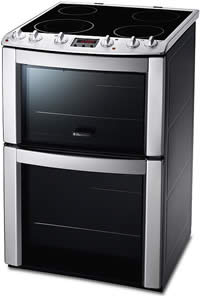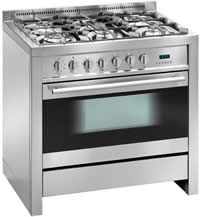Difference between Electric and Gas Ovens
Key Difference: Electric ovens or stoves run on, well as the name suggests, electricity. It converts the electricity into heat in order to cook or bake. Gas ovens run on natural gas, propane, butane, liquefied petroleum gas or other flammable gas as a fuel source. It uses the gas to produce flames in order to cook or bake.
There are two types of common stoves that people can install in their kitchens; Electric and Gas. The objective of both of these ovens are the same, for cooking, however they differ in various ways. Preference of either oven over the other depends on a person and how much they will be cooking or baking in these ovens. While some prefer gas to electric, or vice-versa, both have distinct differences that one should consider before buying either.

Electric ovens or stoves run on, well as the name suggests, electricity. It converts the electricity into heat in order to cook or bake. Electric ovens are more modern compared gas ovens and were invented in the late 19th century by Canadian inventor Thomas Ahearn. The popularity of the electric stove was slow to pick up due to the high prices of electricity. By 1930s, when electricity became cheaper, electric stoves started gaining popularity.
Cost a main factor for people when considering purchases. Though, electric ovens have fewer installation charges, depending on how much a person will cook or bake, running electricity in the long run may become more expensive. The electric oven is praised for its ability to provide even heating, as it provides heat from top, bottom and sides. It is also easy to clean and less susceptible to rusting, as it runs on electricity, which produces dry heat. Major drawbacks of an electric oven are that it is costly, it takes longer to heat up initially, and managing temperature is difficult. Electric ovens are also much easier to repair as only the defective parts need replacing, but the new parts may be more costly.

Gas ovens run on natural gas, propane, butane, liquefied petroleum gas or other flammable gas as a fuel source. It uses the gas to produce flames in order to cook or bake. A gas stove was shown at the1851 World Fair in London, but only in the 1880s did this technology gain popularity. The reason for the delay was attributed to the slow growth of the gas pipe network. Gas oven burners have two types of ignitions, standing pilot and an electric. A standing pilot requires a constant running flame underneath the stove top attached to the burners, while an electric uses sparks to ignite a flame.
Electric ovens are much a cheaper option, while gas stoves are bit more expensive compared to electric stoves when it comes to installation, as additional gas pipes also need to be installed for people buying a gas oven for the first time. However, in the long run natural gas is much cheaper compared to electric oven. Gas ovens are much faster to heat up and cool down, as it does not have to wait for electricity to heat up the coils and then wait for it to cool down. Since fans cannot be installed within the oven, heat is harder to circulate, making heat in the oven uneven. Heat in a gas oven is primarily supplied from the top of the oven. Gas ovens also need professional installation, while electric heaters can be installed by the purchaser. Gas ovens are also much harder to repair and may become costly to maintain. A major benefit of a gas oven is that since it does not depend on electricity, it can also be used during a power out.
In a nutshell, purchasing either a gas oven or an electric oven depends on various factors such as how much a person will cook, budget, maintenance, preference, baking techniques, power outages in the area, etc. A person who may be looking for the benefits of both, can also purchase a dual oven, which has comes with the benefits of an electric oven and a gas cook top.
|
|
Electric Ovens |
Gas Ovens |
|
Runs on |
Electricity |
Natural gas, propane, butane, liquefied petroleum gas or other flammable gas |
|
Price |
Initial set up is less expensive |
Initial set up is more expensive, ex: installation of gas pipe |
|
Heating |
Heats up slower compared to gas ovens |
Heats up faster, as flames are already hot |
|
Economical |
More expensive in the long run |
Less expensive in the long run |
|
Heat distribution |
Even heat distribution |
In old gas ovens heat could not be distributed evenly, but newer technology has eliminated this problem |
|
Temperature Management |
Harder to manage temperature |
Easier to manage temperature with the flames |
|
Burners |
Runs on coils or glass tops |
Runs on flame burners; requires pilot light or electric ignition. |
|
Benefits |
Even oven temperature, easy-to-clean, cheaper installation, cheap repairs |
Instant heat, cheaper in the long run, doesn’t rely on electricity to cook |
|
Limitations |
Expensive in the long run, slow heating, useless during power outage |
Not easy to clean, expensive repairs, danger of leakage, expensive installation |
Image Courtesy: hispek.com, cairosite.files.wordpress.com









Add new comment